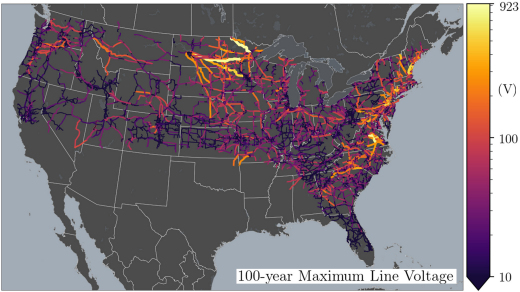A solar superstorm can make your lights go out.
And the most vulnerable regions are near big cities: Denver, Boston, New York, Philadelphia, Baltimore, and Washington, DC.

Bright yellow and orange trace the trouble spots across the contiguous USA.
New maps released by the USGS show where the power is most likely to fail: The Denver metropolitan area, the Pacific northwest, the Atlantic seaboard, and a cluster of Midwestern states near the US-Canadian Border.
Power companies have long been wary of the sun
Solar storms can cause strong electric currents to flow through commercial power lines – so strong that the lines can’t handle it.
Fuses blow, transformers melt, and circuit breakers trip.
The most famous geomagnetic power outage happened during a space storm in March 1989 when six million people in Quebec lost power for 9 hours.
Whether or not ‘your’ power goes out during a solar storm depends on two things:
- The configuration of power lines in your area
- The electrical properties of the ground beneath your feet. In areas of more electrically resistive rock, currents struggle to flow through the ground. Instead, they leap up into overhead power lines – a scenario that played out in Quebec in 1989.
The new maps by Earthscope show the electrical properties of deep rock and soil on a continent-spanning grid with points about 70 km apart.
Peak voltages during huge solar storm
USGS researchers led by Greg Lucas and Jeffrey Love combined this information with the layout of modern power lines to estimate peak voltages during a century-class storm.
Sprawling power lines act like “solar storm antennas,” picking up currents and spreading the problem over a wide area.
They found a huge variation in hazard across the USA.
“The largest estimated once-per-century geoelectric field is 27.2 V/km at a site located in Maine, while the lowest estimated once-per-century geoelectric field is 0.02 V/km at a site located in Idaho. That is more than 3 orders of magnitude difference.”
The next century-class super storm
Notably, some of the most vulnerable regions are near big cities: Denver, Boston, New York, Philadelphia, Baltimore, and Washington, DC.
To complete the hazard map, the researchers are waiting for a new magnetotelluric survey to cover the rest of the USA.
It can’t come soon enough. The last “century-class” geomagnetic storm hit in May 1921 … 99 years ago.
More solar storm news on Strange Sounds and Steve Quayle. [AGU, USGS, SW]













The March 1989 geomagnetic storm occurred as part of severe to extreme solar storms during early to mid March 1989, the most notable being a geomagnetic storm that struck Earth on March 13. This geomagnetic storm caused a nine-hour outage of Hydro-Québec’s electricity transmission system. The onset time was exceptionally rapid.[1] Other historically significant solar storms occurred later in 1989, during a very active period of solar cycle 22.